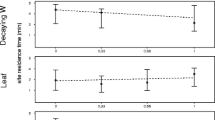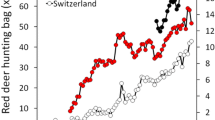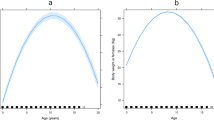Abstract
During winter at northern latitudes, large herbivores often exploit patches of concentrated, relatively high quality forage, which may lead to interference competition. The factors affecting success in contests and subsequent dominance rank, such as age and body weight, remain key issues in ungulate behavioural ecology. Maternal effects on offspring body weight are well known, but few studies have investigated if mother’s social rank influence offspring rank. Moreover, no study has related dominance rank in ungulates to weight loss during winter. Outcomes of social interactions (n=7,609), feeding time and spatial position in red deer (Cervus elaphus) hinds and calves, and weight loss of calves, were registered from 1981 to 1996 at six winter-feeding sites within the county of Sør-Trøndelag in Norway. The level of aggressiveness was higher among calves than among adult hinds, and the factors determining the outcome of contests also differed. The initiator won the majority of interactions (more than 90% in both hinds and calves). Social rank was related to both age and body weight in adult hinds, and related to body weight and mother rank in calves. The relationship between feeding time and rank was non-linear. Feeding time was correlated with rank only among high ranked hinds, while there was no such relationship among low ranked hinds or calves. There was no correlation between winter weight loss and social rank in calves. Our study therefore underlines that, although frequent aggression is observed at artificial feeding sites of northern herbivores, this is not necessarily sufficient to give rise to interference competition.



Similar content being viewed by others
References
Akaike H (1974) A new look at statistical model identification. IEEE T Automat Contr AU-19:716–722
Albon SD, Langvatn R (1992) Plant phenology and the benefits of migration in a temperate ungulate. Oikos 65:502–513
Appleby MC (1980) Social rank and food access in red deer stags. Behaviour 74:294–309
Appleby MC (1982) The consequences and causes of high social rank in red deer stags. Behaviour 80:259–273
Appleby MC (1983) Competition in a red deer stag social group: rank, age and relatedness of opponents. Anim Behav 31:913–918
Barrette C, Vandal D (1986) Social rank, dominance, antler size and access to food in snow-bound wild woodland caribou. Behaviour 97:118–146
Begon M, Harper JL, Townsend CR (1996) Ecology. Individuals, populations and communities. Blackwell Scientific, Boston
Bernstein IS (1981) Dominance: the baby and the bathwater. Behav Brain Sci 4:419–457
Brantas GC (1968) On the dominance on Friesian-Dutch dairy cows. Z Tierzüchtungsbiol 84:127–151
Burnham KP, Anderson DR (1998) Model selection and inference: a practical information-theoretic approach. Springer, Berlin Heidelberg New York
Cederlund G, Liberg O (1995) Rådjuret. Viltet, ekologin och jakten (in Swedish). Svenska Jägareförbundet, Solna
Cheney DL, Seyfarth RM (1990) How monkeys see the world. University of Chicago Press, Chicago
Clutton-Brock TH, Albon SD, Gibson RM, Guinness FE (1979) The logical stag: adaptive aspects of fighting in red deer (Cervus elaphus L.). Anim Behav 27:211–225
Clutton-Brock TH, Guinness FE, Albon SD (1982) Red deer. Behaviour and ecology of two sexes. Edinburgh University Press, Edinburgh
Clutton-Brock TH, Albon SD, Guinness FE (1986) Great expectations: dominance, breeding success and offspring sex ratios in red deer. Anim Behav 34:460–471
Clutton-Brock TH, Iason GR, Guinness FE (1987) Sexual segregation and density-related changes in habitat use in male and female red deer (Cervus elaphus). J Zool (Lond) 211:275–289
Côté SD (2000) Dominance hierarchies in female mountain goats: stability, aggressiveness and determinants of rank. Behaviour 137:1541–1566
Eccles TR, Shackleton DM (1986) Correlates and consequences of social status in female bighorn sheep. Anim Behav 34:1392–1401
Espmark Y (1974) Social behaviour of roe deer at winter feeding stations. Appl Anim Ethol 1:35–47
Fairbanks WS (1994) Dominance, age and aggression among female pronghorn, Antilocapra americana (Family: Antilocapridae). Ethology 97:278–293
Festa-Bianchet M (1991) The social system of bighorn sheep: Grouping pattern, kinship and female dominance rank. Anim Behav 42:71–82
Freeman LC, Freeman SC, Romney AK (1992) The implications of social structure for dominance hierarchies in red deer, Cervus elaphus L. Anim Behav 44:239–245
Greenberg-Cohen D, Alkon PU, Yom-Tov Y (1994) A linear dominance hierarchy in female Nubian ibex. Ethology 98:210–220
Guilhem C, Gerard J-F, Bideau E (2002) Rank acquisition through birth order in Mouflon sheep (Ovis gmelini) ewes. Ethology 108:63–73
Hall MJ (1983) Social organization in an enclosed group of red deer (Cervus elaphus L.) on Rhum. Z Tierpsychol 61:250–262
Hamilton WD (1971) Geometry for the selfish herd. J Theor Biol 31:295–311
Hastie T, Tibshirani R (1990) Generalized additive models. Chapman and Hall, London
Hirotani A (1990) Social organization of reindeer (Rangifer tarandus), with special reference to relationships among females. Can J Zool 68:743–749
Holand Ø, Mysterud A, Wannag A, Linnell JDC (1998) Roe deer in northern environments: physiology and behaviour. In: Andersen R, Duncan P, Linnell JDC (eds) The European roe deer: the biology of success. Scandinavian University Press, Oslo, pp117–137
Illius AW, Gordon IJ (1987) The allometry of food intake in grazing ruminants. J Anim Ecol 56:989–999
Ims RA, Yoccoz NG (1997) Ecological methodology: study design and statistical analysis. University of Oslo, Department of Biology
Lenvik D, Bø E, Fjellheim A (1988) Relationship between the weight of reindeer calves in autumn and their mother’s age and weight in the previous spring. Rangifer 8:20–24
Lindsey JK (1999) Models for repeated measurements. Oxford University Press, Oxford
Loison A, Langvatn R, Solberg EJ (1999) Body mass and winter mortality in red deer calves: disentangling sex and climate effects. Ecography 22:20–30
Lott DF, Galland JC (1987) Body mass as a factor influencing dominance status in American bison cows. J Mammal 68:683–685
Lovari S, Rosto G (1985) Feeding rate and social stress of female chamois foraging in groups. In: Lovari S (ed) The biology and management of mountain ungulates. Croom Helm, London, pp 102–105
Masteller MA, Bailey JA (1988) Agonistic behaviour among mountain goats foraging in winter. Can J Zool 66:2585–2588
Mech LD, Nelson ME, McRoberts RE (1991) Effects of maternal and grandmaternal nutrition on deer mass and vulnerability to wolf predation. J Mammal 72:146–151
Mysterud A, Yoccoz NG, Stenseth NC, Langvatn R (2001) The effects of age, sex and density on body weight of Norwegian red deer: evidence of density-dependent senescence. Proc R Soc Lond B Biol Sci 268:911–919
Reinhardt V, Reinhardt A (1975) Dynamics of social hierarchy in a diary herd. Z Tierpsychol 38:315–323
Rutberg AT (1986) Dominance and its fitness consequences in American bison cows. Behaviour 96:62–91
Schein MW, Fohrman MV (1955) Social dominance relationships in a herd of diary cattle. Br J Anim Behav 3:45–55
Schmidt KT, Hoi H (1999) Feeding tactics of low-ranking red deer stags at supplementary feedings sites. Ethology 105:349–360
Skogland T (1994) Villrein: fra urinnvåner til miljøbarometer (in Norwegian). Teknologisk Forlag, Oslo
Suttie JM (1983) Body size: dominance relationships in red deer stags calves. Anim Behav 31:610–611
Thouless CR (1990) Feeding competition between grazing red deer hinds. Anim Behav 40:105–111
Thouless CR, Guinness FE (1986) Conflict between red deer hinds: the winner always wins. Anim Behav 34:1166–1171
Tyler SJ (1972) The behaviour and social organization of the New Forest ponies. Anim Behav Monogr 5:87–196
Venables WN, Ripley BD (1999) Modern applied statistics with S-plus. Springer, Berlin Heidelberg New York
Weckerly FW (1999) Social bonding and aggression in female Roosevelt elk. Can J Zool 77:1379–1384
Acknowledgements
We thank Nigel G. Yoccoz for statistical advice, Nathalie Pettorelli, Jean-Michel Gaillard and one anonymous referee for comments which improved an earlier version of the manuscript, and Magnhild Slørdahl and Anders Mjønes for their great hospitality during periods of field work. We gratefully acknowledge the financial support given by the Research Council of Norway to L.E. Loe and A. Mysterud.
Author information
Authors and Affiliations
Corresponding author
Rights and permissions
About this article
Cite this article
Veiberg, V., Loe, L.E., Mysterud, A. et al. Social rank, feeding and winter weight loss in red deer: any evidence of interference competition?. Oecologia 138, 135–142 (2004). https://doi.org/10.1007/s00442-003-1399-9
Received:
Accepted:
Published:
Issue Date:
DOI: https://doi.org/10.1007/s00442-003-1399-9




